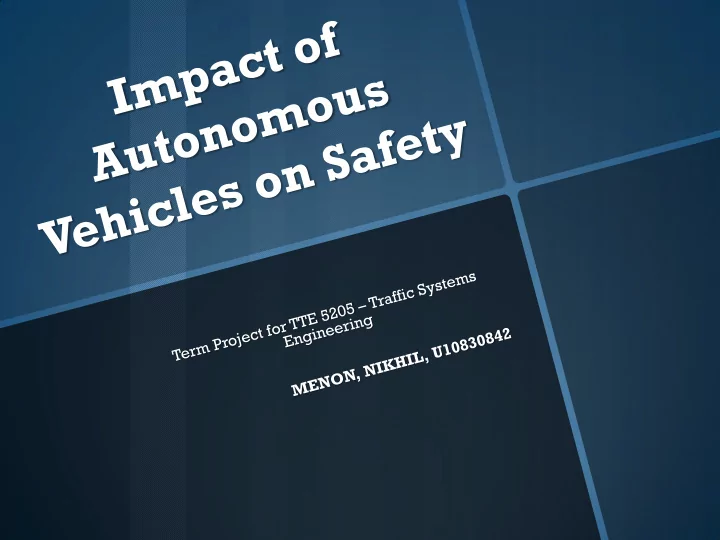

This term paper explores the impact of autonomous vehicles on safety. In doing so, the paper aims to delve deeper into the aspects of the need for a safety – centric technology enhancement. An insight into the most possible causes of such an excitement in the field of autonomous vehicles has a lot to do with the safety and so, a review of the safety enhancement technologies in these vehicles shall be covered. However, challenges shall still remain in order to fulfill the longer term goal of seamless adoption and integration of this technology. The last part of this paper shall deal with that aspect in detail.
BACKGROUND AUTONOMOUS VEHICLES WHY SAFETY?? (IMPACTS) SAFETY ENHANCEMENT TECHNOLOGIES (REVIEW) MARKET PENETRATION CHALLENGES
• GM presented a vision for “driverless cars” ( 1939) 1 • US DOT initiatives heralded by Pre 1980 advancements in computing technology (late 60s – late 70s) • NAHSRP – main goal: develop specifications for a fully automated highway system. • NAHSC 2 – motivation: help build 1990s broad interests required for early development & deployment of fully automated highway systems. • DARPA Grand Challenge 3 – 2004, 2005 & 2007. • Thrust towards advancement in related technology – > ACC, self – 2000s parking, automatic lane keeping & crash avoidance systems.
Lot of excitement since 2012 KPMG (2012 ) Potential benefits: Additional mobility option for elderly. Better & more productive use of travel time. Safer alternative- very high crash reduction possibilities Reduction in emission & fuel consumptions – better driving & braking standards Increased capacity on highways due to closer spacing of vehicles on the road.
Fatality rates for year 2007 – 41059 (US) 4 , ~ 40000 (EU) 5 . Automotive industry indulging in active research on crash avoidance technologies due to the massive benefits from the same. Benefits Crash reduction – human error plays a dominant role in >90% of the crashes; sole reason for crashes (75% cases) 7 Of these 75% crashes, 41% - recognition errors & 34% - driver indecision. Braking failure – 25% of all crashes; braking one second earlier reduced all brake related crashes by half. 6 Billions of dollars in crash related losses saved !!!
Lane Departure Warning System (LDWS) Lane Keeping Assist Lateral Control Systems (LKA) Parallel Parking Safety enhancement Assist technologies (Control systems) Adaptive Cruise Control (ACC) Longitudinal Control Pre Crash Braking Assist Lane Departure Warning Systems • (LDWS) • “to avoid run – off road and sideswipe crashes and to support the driver in lane – keeping. ” 8 • Methods: • Embedded magnetic markers on the field (most accurate) 9 • Highly accurate GPS maps. • Image processing (most suitable) 7
Konca M & Forrest A (2007 ) Lane Keeping Assist Systems (LKA) • small adjustments to the steering to ensure • that the vehicle stays in the same lane. • only a small amount of torque required to overcome actuation 11 – > driver alertness issue – > rectified by asking for certain driver input over time. • Parallel Parking Assist fitted with a rear view cam assisting the driver • while he controls the braking & acceleration.
Adaptive Cruise Control (ACC) • • controlling the speed at which the vehicle moves wrt vehicle immediately ahead. dynamic process, speed shifts occur all • the time. when the vehicle ahead moves into • another lane, speed reset again. 11 Konca M & Forrest A (2007 ) Pre – Crash braking assist • use ACC to detect possible collisions. • If high rate, pre – arm the brakes; • reduces SSD. • reduces collisions due to bad braking. 11 •
Littman (2013 ) Littman (2013 ) KPMG (2012 )
Reliability & Robustness of Technology “ Since cars will likely travel more closely together than they do currently, fail – safe braking is one essential to avoid a chain collision. Also, it’s hard to see autonomy getting much traction until sensor technology is widely installed on cars – they have to talk with each other for it to work. ” - Dr. Azim Eskandarian . Other apprehensions – GPS spoofing, non – performance of LIDAR in inclement weather . Altera (2010)
Consumer Perception & Market Penetration Skepticism towards autonomous vehicles is a consequence of trust (mistrust) “Public opinion can be gained only by demonstration, not by use . ” – Prof Clifford Nass. Consumers willing to cede “control” to the autonomous vehicle only if the vehicle drives more adeptly than human. Major deterrent – the idea that a machine could kill a human being, despite their very slim chances. Skill degradation – major issues during possible system failures. FAA advised pilots to fly more manual than autopilot. Risk homeostasis – drivers willing to accept more risks as they blindly believe in technology. Kurzweil (2011 )
Legislation & Liability Morris - BC Legislation is cloudy over the status of autonomous vehicles; different states have different rules. (Legal: CA, NV , FL) Future issues dealt in terms of negative liabilities – > what is not illegal, is legal . (Dr. Ryan Calo) Universally acceptable legislation lacking – > direct impact on safety in the minds of the consumer. Major liability issues – > nobody wants to be blamed during the event of a crash. Directly impacting insurance companies which provide cover for these risks. Risks?? What kind of risks?? Even they don’t know that.
Recommend
More recommend